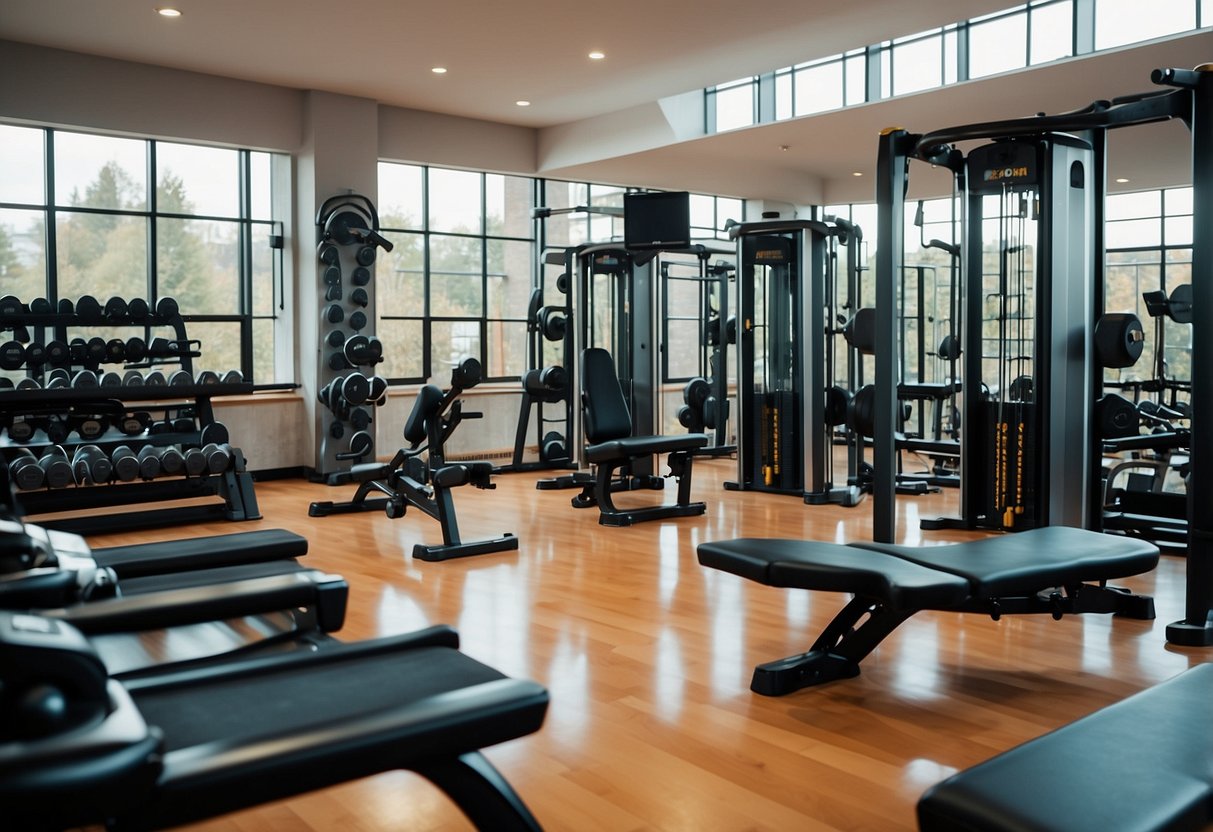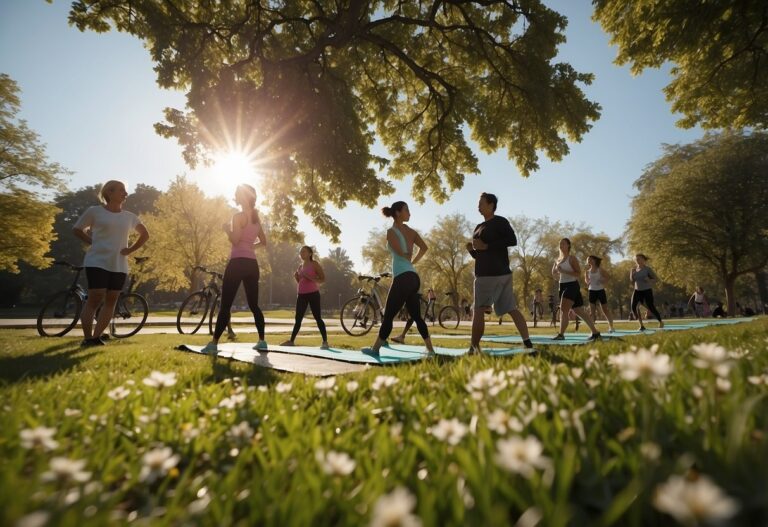Preventing injuries during workouts is crucial for maintaining your fitness journey and achieving your goals. It’s easy to get caught up in the excitement of a new routine or pushing for that personal best, but neglecting safe practices can lead to setbacks. Why risk injury when a few simple habits can keep you on track and feeling great?

Staying injury-free not only helps you progress steadily but also keeps your motivation high. You might be surprised at how small adjustments can make a big difference in your overall health and performance. By focusing on prevention, you can enjoy your workouts more and ensure your body stays strong and resilient.
Warm up before exercise
Warming up is essential to prevent injuries and improve your workout. It prepares your muscles and joints for more intense activity.
Start with light exercises like marching on the spot for 3 minutes to get your blood flowing. You can find more details on this routine on the NHS website.
Incorporate some dynamic stretches. For example, you can do leg swings or arm circles. This helps increase your range of motion and flexibility.
Try some light weight exercises. If you usually do push-ups on the floor, start with push-ups against a countertop, as suggested by Nerd Fitness.
Don’t forget to include simple moves like squats and lunges. These movements can get your muscles engaged. Check the Healthline guide for a variety of warm-up exercises.
A good warm-up supports a smoother and safer workout.
Use Proper Form
When you’re working out, always make sure your form is correct. Proper form helps you avoid injuries and get the most out of your exercises.
For example, if you’re lifting weights, start with lighter weights to practice your technique before moving on to heavier ones. Use a mirror to check your posture.
Pay attention to how professionals do each move. Watching and learning from experienced trainers can help you perfect your own form.
Always engage your core to support your spine. This keeps your back safe and makes your workout more effective.
Don’t rush through exercises. Slow, controlled movements are key to maintaining good form and preventing injuries. Using proper form sets a solid foundation for any workout routine.
Don’t Skip the Cooldown
Skipping the cooldown after a workout might seem tempting, especially when you’re in a hurry. But taking a few extra minutes can make a big difference in how you feel later.
When you cool down, you give your body time to return to its normal state. This helps reduce the risk of muscle cramps and dizziness. Cooling down also improves blood flow, making it less likely you’ll feel faint or sick after exercising.
Stretching during your cooldown is crucial too. It helps in maintaining flexibility and range of motion. Your muscles are warm, so it’s the perfect time to stretch safely and effectively.
Incorporating a cooldown can also prevent injuries by making your muscles and joints more ready for your next workout. This simple step can make your exercise routine much safer and more enjoyable over time.
Remember, even just a few minutes of light walking or stretching can be enough. It’s a small investment that pays off in big ways. For more details, check here.
Listen to Your Body
Pay attention to what your body is telling you during workouts. Notice the basic signals it sends, like thirst or fatigue. This helps you understand when to push harder and when to rest.
If you’re feeling too tired, it’s okay to slow down or take a break. Doing so can actually prevent injuries and help you stay consistent with your workouts.
Hydrate well by drinking water before, during, and after exercising. Staying hydrated keeps your body functioning properly and reduces the risk of muscle cramps.
You might feel sore after intense workouts. That’s normal. If the soreness is too much, consider an active rest day with light activities like walking.
Adjust your workouts based on how you feel. Some days you might have more energy for a hard session, and other days a gentle exercise might be better.
Stay Hydrated
Drinking enough water is essential to avoid injuries during your workout. Hydration helps keep your muscles and joints functioning properly.
Have you ever felt dizzy or had cramps during exercise? This could be due to dehydration. Drinking water before, during, and after your workout helps maintain your energy levels and prevents these issues.
Consider using a hydration pack or water bottle while exercising. Sipping water frequently helps you stay hydrated without feeling bloated. It’s an easy way to avoid dehydration-induced problems.
Wear appropriate footwear
Choosing the right shoes for your workout is crucial. Good footwear can protect you from injuries and enhance your performance.
Weightlifting shoes with minimal cushioning help you create more force when lifting. They often have a slight heel, which helps you squat deeper.
For running, choose shoes with good cushioning. This reduces the impact on your joints, preventing pain and injury. Make sure your shoes support your whole foot, including the ankle.
Always check your shoes for wear and tear and replace them regularly. Shoes in poor condition do not provide the necessary support and can lead to injuries.
Progress Slowly

When starting a new workout routine, it’s important to pace yourself. Rushing into intense workouts can lead to injuries. Begin with light exercises and gradually increase the intensity.
For example, if you’re new to running, start with short distances. Gradually add more miles each week. Following the rule of not increasing your mileage by more than 10% a week can help prevent injuries. This gradual progression allows your muscles and ligaments to adjust properly.
Weight training also requires a steady approach. Begin with lighter weights, focusing on proper form. Slowly increase the weight as your strength improves. This helps in building a strong foundation without overloading your muscles.
Include rest days
Taking rest days is crucial for your workout routine. Your muscles need time to repair and grow after exercising. If you skip rest days, you might end up with sore muscles or even injuries.
By including rest days, you allow your body to recover from physical stress. This means you’ll perform better during your next workout. Think about this: If you push too hard without rest, your performance might drop instead of improve.
Balance is key. Schedule regular rest days to help prevent overtraining and reduce your risk of injury. It’s all about giving your body the time it needs to stay strong and healthy.
Strengthen core muscles
Strengthening your core muscles is vital to prevent workout injuries. Your core includes muscles like the abs, obliques, and lower back.
Think of your core as the stabiliser for your whole body. When it’s weak, other muscles may try to compensate, leading to injuries. You can avoid this by regularly doing core exercises.
Simple exercises like planks, bridges, and leg raises can make a big difference. Do you feel your lower back getting sore? It might be a sign your core needs some attention.
Practising these exercises three times a week can help improve your stability. Remember, a strong core not only prevents injuries but also boosts your workout performance. For more tips on core exercises, check out the Mayo Clinic.
Cross-train with different activities
Cross-training is one of the best ways to prevent workout injuries. It’s all about mixing up your exercises to work different muscle groups. Instead of just running, try activities like swimming or cycling. This helps to avoid overusing the same muscles.
Swimming is a great option. It’s a low-impact activity that gives your joints a break while still providing a tough workout.
Cycling is another excellent choice. It strengthens your legs and improves your endurance without the pounding your body takes from running.
Strength training is also important. Incorporate weightlifting or bodyweight exercises like squats and lunges. This helps build muscle and improves your overall stability, reducing the risk of injury.
Adding yoga or pilates can enhance your flexibility and balance. These activities stretch out tight muscles and improve your core strength.
Trying different sports, like basketball or tennis, can make your workouts more fun and less repetitive. They also engage different muscle groups and improve coordination.
Experiment with different activities to find what you enjoy the most. This variety not only keeps you engaged but also lowers the risk of injury from repetitive stress.
For more detailed ideas, check out this guide to cross-training from Runner’s World.
Common Causes of Workout Injuries
Preventing workout injuries involves understanding their common causes. Key reasons include poor technique, lack of warm-up, and overtraining. Recognising these issues can help you avoid injuries and enhance your fitness routine.
Poor Technique
Using poor technique while exercising is a major cause of injuries. When you perform exercises incorrectly, you put unnecessary strain on your muscles and joints. This strain can lead to problems like muscle tears, sprains, and even fractures. For example, if you don’t maintain the right posture while lifting weights, you might hurt your back or shoulders. It’s essential to learn the correct form for every exercise you do. Videos, mirrors, or advice from trainers can help you get it right. Investing time in mastering the right technique can save you a lot of pain and recovery time. Remember, slow and accurate movements are better than rushing through your workout.
Lack of Warm-Up
Skipping a warm-up is another frequent cause of workout injuries. Engaging in intense activity without warming up can surprise your muscles, making them more likely to tear or strain. Warm-up exercises, like light jogging or dynamic stretches, prepare your body for strenuous activity. They increase blood flow to your muscles, making them more flexible and less prone to injury. Aim for a warm-up that lasts at least five to ten minutes. Activities like brisk walking, arm circles, or leg swings are effective. Always ensure you’re gradually increasing your heart rate and loosening up your joints and muscles before moving on to more intense workouts.
Overtraining
Overtraining happens when you push your body too hard without giving it enough time to recover. This can lead to fatigue, decreased performance, and a higher risk of injuries like stress fractures or tendinitis. It’s crucial to schedule rest days into your fitness routine and listen to your body. If you feel unusually tired or sore, taking a break can be more beneficial than forcing another workout. Incorporating variety in your exercises, such as alternating between cardio and strength training, can also help prevent overuse injuries. Ensure you’re eating well and staying hydrated to support muscle recovery and overall health.
Preventative Measures
When exercising, it’s important to follow specific steps to avoid injuries. Using proper form and technique and progressing gradually are crucial to staying safe and healthy.
Proper Form and Technique
Using the correct form and technique during workouts protects your body from unnecessary strain. Pay attention to how your body moves during exercises. Small adjustments can often make a big difference in preventing injuries.
Consider working with a trainer, especially when learning new exercises. They can provide guidance and recommend proper form and technique. For example, keeping your knees slightly bent when lifting weights can prevent knee injuries.
Use mirrors in the gym to check your posture. This helps you maintain the right alignment. Don’t rush through exercises; controlled movements are safer and more effective.
Listening to your body is key. If something feels off or painful, stop and reassess your form. Regularly incorporating stretching and flexibility exercises can also improve your technique and reduce the risk of injury. Stretching improves muscle function and makes your range of motion better, which is essential for many activities. These steps help create a strong foundation for your workouts, keeping injuries at bay.
Gradual Progression
Jumping into intense workouts too quickly can lead to injuries. Start with lighter weights or lower intensity and gradually increase. This allows your muscles and joints to adjust to the new demands you are placing on them.
Begin your routine with a proper warm-up. Warming up preps your body for exercise and reduces the chance of pulls or strains. A cool-down is equally important; it helps your body recover and gets you ready for your next workout.
Set realistic goals. If you’re new to exercise, start with basic movements and slowly add complexity. Over time, you’ll be able to handle more challenging workouts without injury. Mixing up your routine can help balance the stress on your body and prevent overuse injuries. For example, combining cardio, strength training, and flexibility exercises offers a well-rounded approach.
Additionally, take rest days seriously. Recovery is when your body repairs and strengthens itself, which is essential for progress and injury prevention. By giving your body the time it needs, you’ll maximise the benefits of your workouts and stay injury-free.
Importance of Rest and Recovery
When you exercise, your muscles experience tiny tears. Rest is crucial for these muscles to repair and grow stronger. Resting after a workout isn’t just about avoiding fatigue; it’s about making sure your body recovers properly to prevent injuries.
When you engage in intense exercise, your muscles need about 48-72 hours to repair and strengthen. Skipping rest can lead to overuse injuries, which are much harder to treat. Proper rest helps your muscles and joints recover, keeping you fit and injury-free.
Mind and Body Balance
Taking rest days can also help balance your life. Over-training can lead to burnout, making it hard to stay motivated. Giving your body a break allows you to stay fresh and enthusiastic about your fitness goals. This balance between workouts and rest is essential for a sustainable routine.
Active Recovery Can Help
Not all rest means doing nothing. Active recovery, like light cycling or walking, can increase blood flow and help remove waste products from your muscles. This speeds up the healing process and keeps you moving without putting too much stress on your body. Dr. Karin VanBaak discusses how active recovery increases blood circulation, aiding muscle repair.
Avoid Burnout
Pushing through fatigue might seem like a good idea, but it often leads to burnout. Without enough rest, you can feel tired and demotivated, affecting your performance. Adequate rest ensures that you remain energetic and ready for your next workout.
Injury Prevention
Preventing injuries is one of the most important aspects of training. Rest and recovery reduce the risk of overuse injuries, which can occur due to continuous stress without proper recovery time. Adequate rest helps keep you strong and healthy, reducing the likelihood of injuries. Learn more about how rest prevents injuries.







